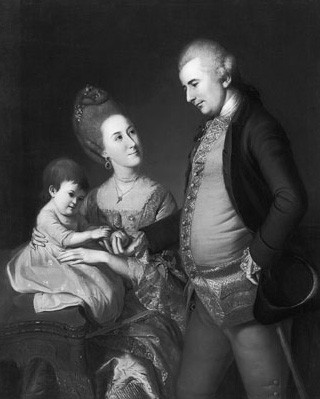
Charles Wilson Peale, Portrait of John and Elizabeth Lloyd Cadwalader and their daughter, Anne. Oil on canvas, 51 1/2" x 41 1/4". Courtesy: Philadelphia Museum of Art. Purchased for the Cadwalader Collection with funds contributed by the Mabel Pew Myrin Trust and the gift of an anonymous donor, 1983.
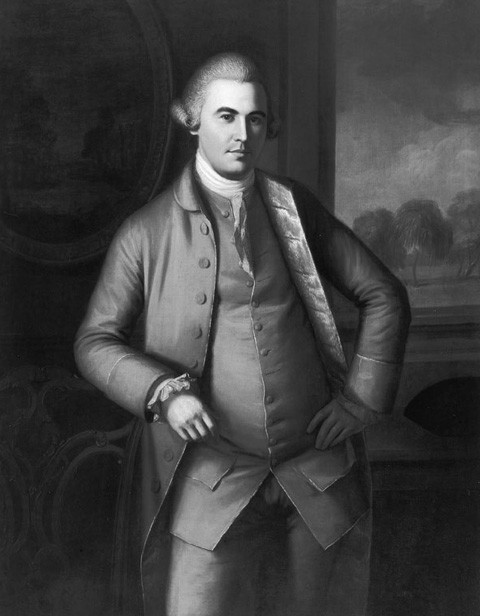
Charles Wilson Peale, Portrait of Colonel Lambert Cadwalader. Oil on canvas, 51" x 41". Courtesy: Philadelphia Mueseum of Art. Purchased for the Cadwalader Collection with funds contributed by the Mabel Pew Myrin Trust and the gift of an anonymous donor, 1983
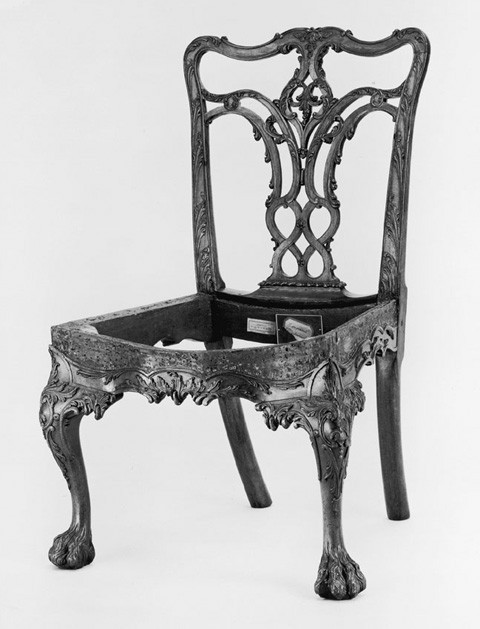
Side chair, Philadelphia, ca. 1769. Mahogany with white cedar. H. 36 3/4", W. 21 3/4" (seat), D. 177/8" (seat). (Courtesy, Chipstone Foundation; photo, Hans Lorenz.)
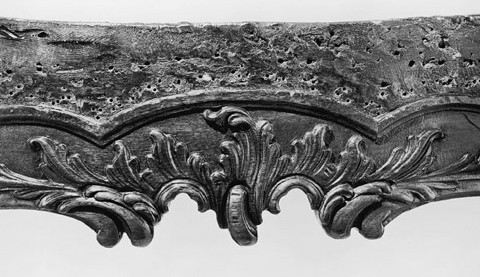
Detail of the carving on the front rail of the side chair illustrated in fig. 3.
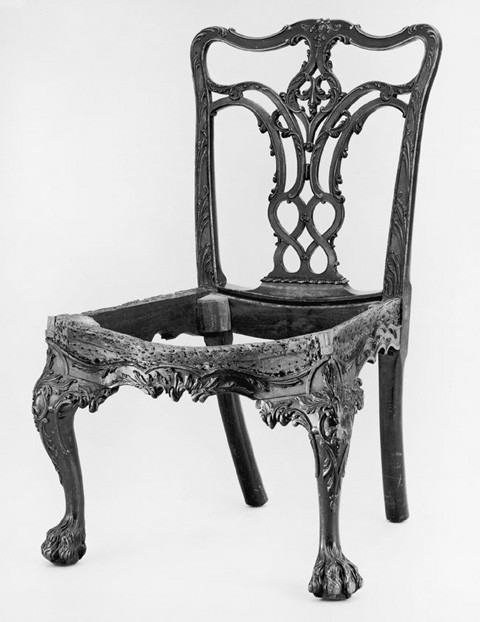
Side chair, Philadelphia, ca. 1769. Mahogany with white cedar. H. 37 1/16", W. 21 3/4" (seat), D. 18" (seat). (Courtesy, Colonial Williamsburg Foundation; photo, Hans Lorenz.)

Detail of the carving on the front rail of the side chair illustrated in fig. 5. The tradesmen who made the chairs in this set used a combination of planes, chisels, files, and scrapers to prepare the upholstery surfaces on the front and side rails. Because the front rails are serpentine, they used a curved toothing plane to finish the area for the foundation upholstery (approx. 1"– 11/4" at the top) and chisels, files, and scrapers to prepare the surface below. On the side rails, they used a standard smoothing plane to finish the area for the foundation upholstery and chisels, files, and scrapers below.
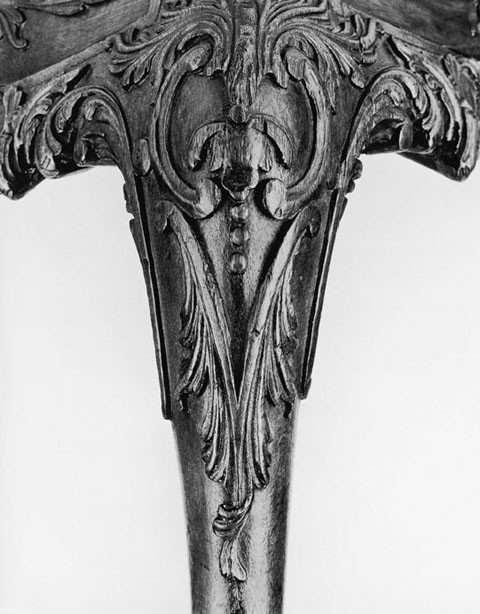
Detail of the knee carving on the side chair illustrated in fig. 3.
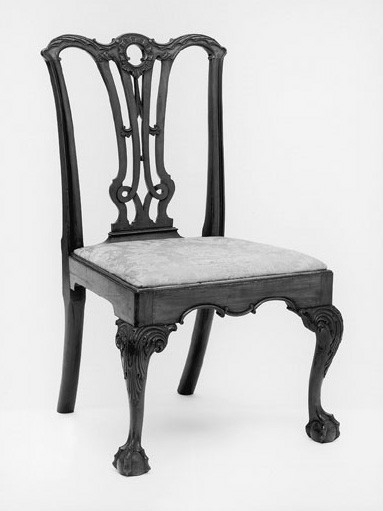
Side chair with the label of Benjamin Randolph, Philadelphia, ca. 1770. Mahogany. H. 38 3/8", W. 23 3/4", D. 19". (Courtesy, Museum of Fine Arts, Boston, M. and M. Karolick Collection, © 2000, all rights reserved.)
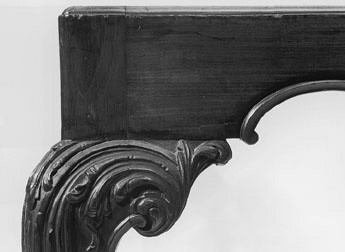
Detail of the knee carving on the side chair illustrated in fig. 8.

View of the Stamper-Blackwell parlor. (Courtesy, Winterthur Museum.)
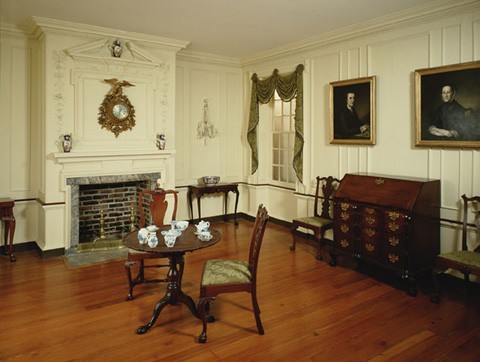
View of the Ringgold parlor. (Courtesy, Baltimore Museum of Art.) The Ringgold house was one of two residences on Maryland’s eastern shore with architectural carving imported from Philadelphia. The other is Cloverfields in Queen Anne’s County. Philadelphia carvers shipped architectural carving as far south as Charleston, South Carolina.
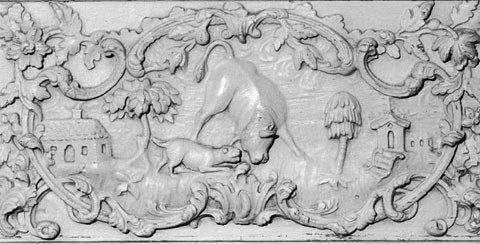
Detail of the center tablet on the chimneypiece in the Stamper-Blackwell parlor. The scrolls and leaves framing the central scene are taken from the tablet design illustrated in fig. 14.

Detail of one of the frieze appliqués on the chimneypiece in the Ringgold parlor. This frieze appliqué is based on the design shown in fig. 15, but it is inverted.
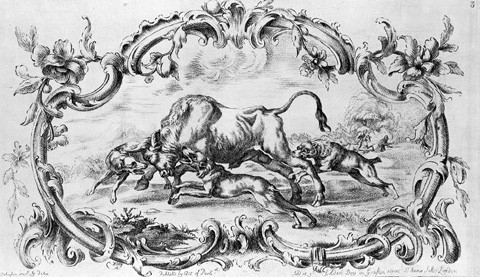
Design for a tablet illustrated in Thomas Johnson, A New Book of Ornaments (1762). The only complete copy of this publication is in the Victoria and Albert Museum. It consists of six patterns “Designed for Tablets & Friezes for Chimney-Pieces.”

Design for a frieze illustrated in Thomas Johnson, A New Book of Ornaments (1762).
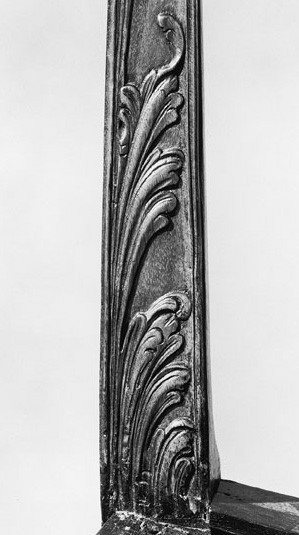
Detail of the acanthus carving on the left stile of the side chair shown in fig. 3.
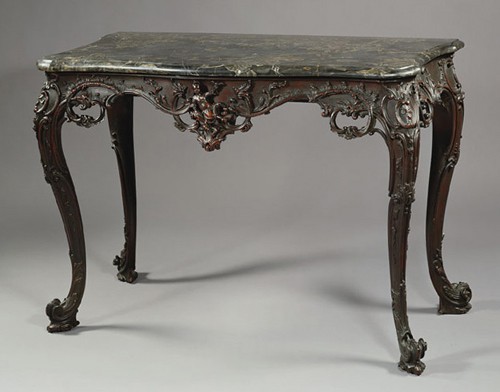
Pier table, Philadelphia, 1765–1769. Mahogany with yellow pine; marble. H. 32 3/8", W. 48", D. 23 1/4". (Courtesy, The Metropolitan Museum of Art, John Stewart Kennedy Fund, 1918 (18.110.27) Photograph © 1991 The Metropolitan Museum of Art.) Two large scrolls are missing from the lower edge of the table.
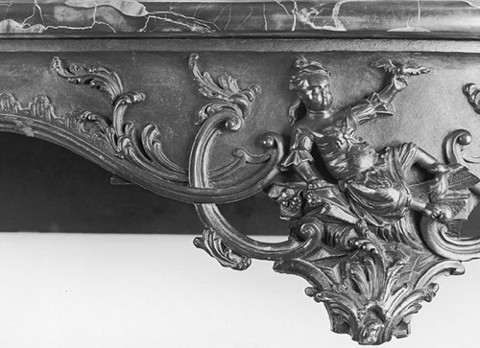
Detail of the carved figure in the center of the table illustrated in fig. 17. (Courtesy, The Metropolitan Museum of Art, John Stewart Kennedy Fund, 1918 (18.110.27) Photograph © 1991 The Metropolitan Museum of Art.)
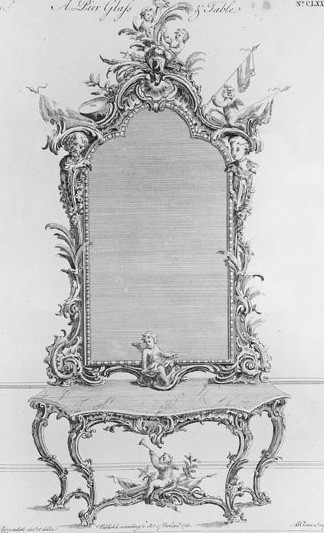
Design for a pier glass and table illustrated on pl. 152 in the third edition of Thomas Chippendale’s Gentleman and Cabinet-Maker’s Director (1762). (Courtesy, Winterthur Museum.)
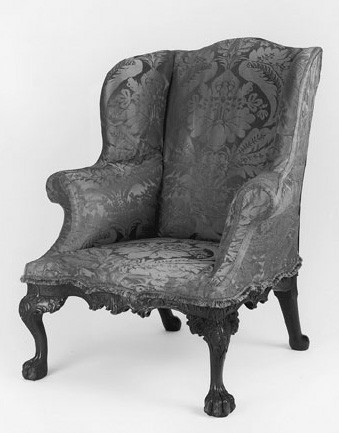
Easy chair attributed to Thomas Affleck, Philadelphia, 1771. Mahogany with yellow pine, white oak, white cedar, black walnut, and tulip poplar. H. 45". (Courtesy, Dietrich Americana Foundation.) The carving on this chair is attributed to the shop of Nicholas Bernard and Martin Jugiez

Detail of one of the webbing sites on the seat rails of the chair illustrated in fig. 3. Each site is indicated by a cluster of nail holes approximately 1 7/8" wide.
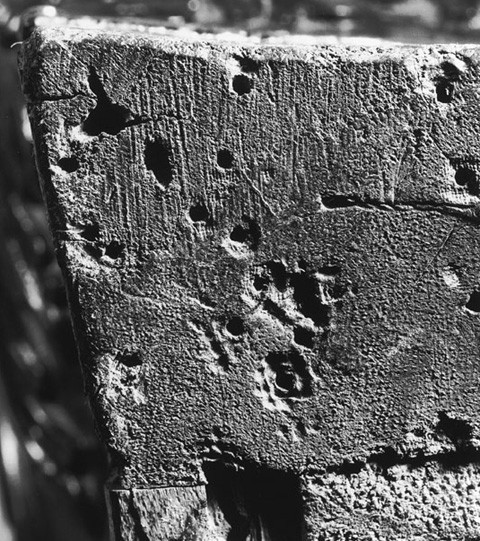
Detail of the right leg of the chair illustrated in fig. 3, showing file marks from the removal of the upholstery peak. The peaks on the commode-seat chairs were approximately 1/2" high.

Detail of the front seat rail of the chair illustrated in fig. 5, showing nailing patterns for securing the (a) upholstery roll and (b) top canvas.

Ultraviolet photograph showing the front rail of the chair illustrated in fig. 5. The area covered by the foundation upholstery flouresces differently from that covered by finish.
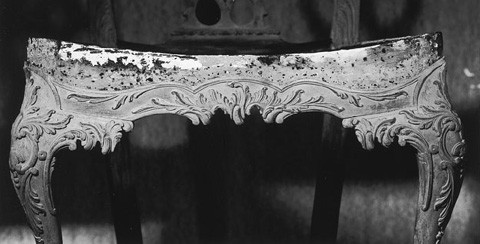
Ultraviolet photograph showing the front rail of the chair illustrated in fig. 3. The area of the seat rail covered by the foundation upholstery flouresces differently from that covered by finish.
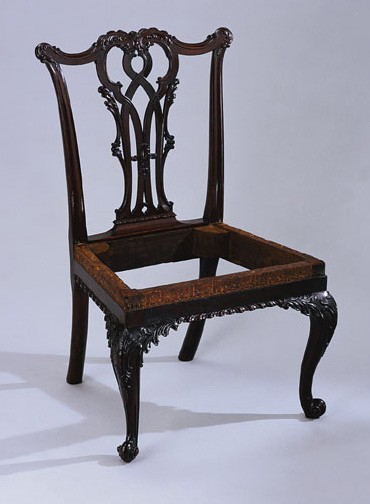
Side chair, Philadelphia, 1765–1775. Mahogany with tulip poplar. H. 41 1/2", W. 27", D. 15 1/2". (Courtesy, Colonial Williamsburg Foundation; photo, Hans Lorenz.)
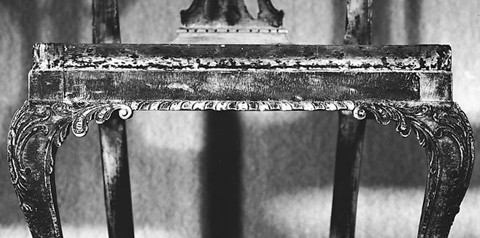
Detail of the front seat rail of the chair illustrated in fig. 26. The area covered by the foundation upholstery flouresces differently from that covered by finish.

Detail showing two of the six spoon bit holes used for tying on the slipcover of the chair shown in fig. 5.
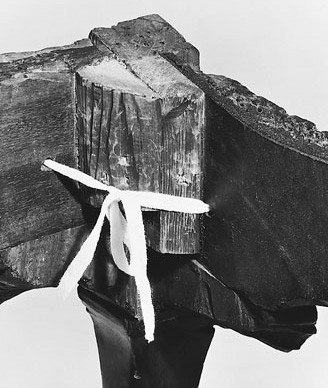
Detail showing how the slipcovers of the commode-seat chairs would have been tied off.
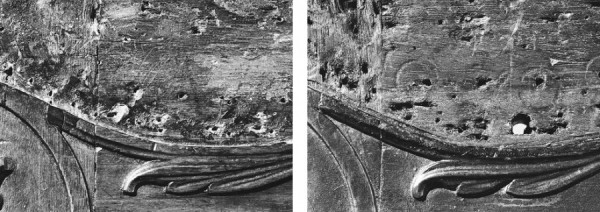
Detail of the nailing line for fixed upholstery on the front rail of (left) the chair illustrated in fig. 3 and (right) the chair illustrated in fig. 5.
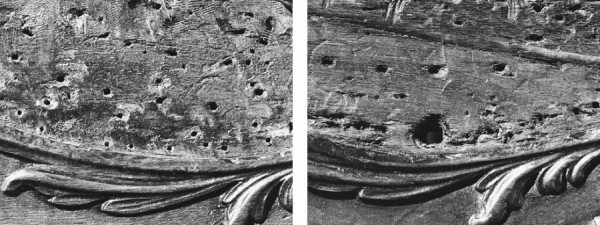
Detail of the nailing line for fixed upholstery on the side rail of (left) the chair illustrated in fig. 3 and (right) the chair illustrated in fig. 5.
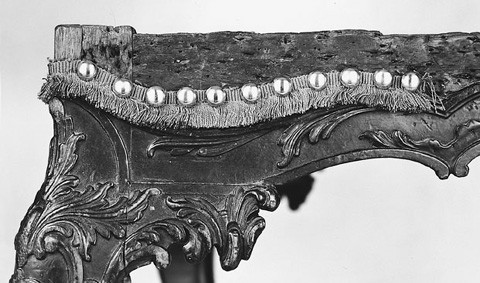
Detail of the side chair illustrated in fig. 5 showing how the fringe of a reused slipcover would have been nailed to the side rail.
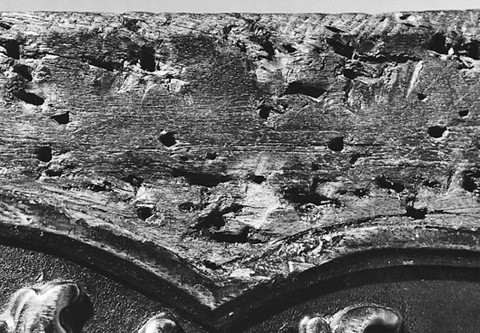
Detail of the tacking evidence adjacent to the carved strapwork on the rails of the seat of the side chair illustrated in fig. 5.
